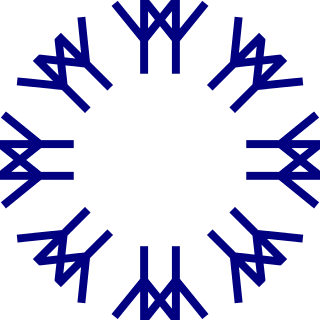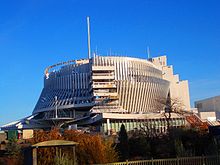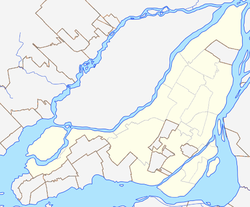
The 1967 International and Universal Exposition, commonly known as Expo 67, was a general exhibition from April 28 to October 27, 1967. It was a category one world's fair held in Montreal, Quebec, Canada. It is considered to be one of the most successful World's Fairs of the 20th century with the most attendees to that date and 62 nations participating. It also set the single-day attendance record for a world's fair, with 569,500 visitors on its third day.

Jean Drapeau was a Canadian politician who served as mayor of Montreal for 2 non-consecutive terms from 1954 to 1957 and from 1960 to 1986. Major accomplishments of the Drapeau Administration include the development of the Montreal Metro entirely underground mass transit subway system running on 'whisper quiet' rubber wheels, a successful international exposition Expo 67 as well as the construction of a major performing arts centre, the Place des Arts. Drapeau also secured the hosting of the 1976 Summer Olympics and was instrumental in building the Olympic Stadium and then world's tallest inclined tower. Drapeau was responsible for securing a Major League Baseball franchise, with the creation of the Montreal Expos in 1969. Drapeau's main legacy is Montreal's attainment of global status under his administration.

Saint Helen's Island is an island in the Saint Lawrence River, in the territory of the city of Montreal, Quebec, Canada. It forms part of the Hochelaga Archipelago. It is situated immediately offshore from Old Montreal on the southeastern side of the Island of Montreal in southwestern Quebec, and is part of the central borough of Ville-Marie. The Le Moyne Channel separates it from Notre Dame Island. Saint Helen's Island and Notre Dame Island together make up Jean-Drapeau Park.

Notre Dame Island is an artificial island in the Saint Lawrence River in Montreal, Quebec, Canada. It is immediately to the east of Saint Helen's Island and west of the Saint Lawrence Seaway and the city of Saint-Lambert on the south shore. Together with Saint Helen's Island, it makes up Parc Jean-Drapeau, which forms part of the Hochelaga Archipelago. To the southeast, the island is connected to the embankment separating the seaway and Lachine Rapids.

The Yellow Line, also known as Line 4, is one of the Montreal Metro's four routes operating in Montreal, Quebec, Canada.

Jean-Drapeau station is a Montreal Metro station in Montreal, Quebec, Canada. It is operated by the Société de transport de Montréal (STM) and serves the Yellow Line. It is situated on the Saint Helen's Island in the Saint Lawrence River.

Loto-Québec is a crown corporation in the Canadian province of Quebec. Established in 1969, it is responsible for overseeing lottery and gaming in the province.

The Biosphere, also known as the Montreal Biosphere, is a museum dedicated to the environment in Montreal, Quebec, Canada. It is housed in the former United States pavilion constructed for Expo 67 located within the grounds of Parc Jean-Drapeau on Saint Helen's Island. The museum's geodesic dome was designed by Buckminster Fuller.

La Ronde is an amusement park located in Montreal, Quebec, Canada. It was originally built as the entertainment complex for Expo 67, the 1967 World Fair. Today, it is operated by Six Flags, under an emphyteutic lease with the City of Montreal until 2065. In-addition to being the Six Flags chain's northernmost location, La Ronde is the largest amusement park in Quebec and the second-largest in Canada.
This is a list of landmarks of Montreal.

Jean Drapeau Park is the third-largest park in Montreal, Quebec, Canada. It comprises two islands, Saint Helen's Island and the artificial island Notre Dame Island, situated off the shore of Old Montreal in the Saint Lawrence River.

The Société des casinos du Québec is a subsidiary of Loto-Québec, a government of Québec corporation. The Société des casinos du Québec oversees all four government-run casinos in the province of Québec: the Casino de Montréal, the Casino du Lac-Leamy, the Casino de Mont-Tremblant, and the Casino de Charlevoix.

The Expo 67 International and Universal Exposition featured 90 pavilions representing Man and His World, on a theme derived from Terre des Hommes, written by the famous French pilot Antoine de Saint-Exupéry.

Cité du Havre is a neighbourhood in the borough of Ville-Marie of the city of Montreal, Quebec, Canada. It is located on a narrow man-made peninsula, the Mackay Pier, which was largely built to protect the Old Port of Montreal from the currents of the Saint Lawrence River and from ice banks and floodings in the springtime.

The Québec Pavilion was a pavilion at Expo 67 in Montreal on Notre Dame Island. It featured modern architecture and exhibited Quebec's urban and industrial growth.

Melvin Charney C.Q. was a Canadian artist and architect.
Le Faubourg à m'lasse was a neighborhood in Montreal until 1963. The neighborhood was bordered by Dorchester Boulevard to the North, Wolfe Street to the West, Viger Avenue to the South, and Papineau Avenue to the East.
Jean Dumontier was a Canadian-Quebecois architect and artist. He is best known for having designed the Montreal Metro stations Jean-Drapeau and Longueuil-Université-de-Sherbrooke. He was also the first architect of the subway to have himself created the works of art for the stations of his own design, those being the four concrete walls of the dock of the station Jean-Drapeau.
Gambling in Quebec includes Casino gambling in most crowded cities of the region, Lottery, Société des casinos du Québec and Sports betting. Games of chance have existed during the prohibition era but became legal in Quebec only in 1985 when gambling was made legal in the country. Unlike most Canadian provinces where the minimum age for gambling is nineteen, in Quebec, along with Alberta and Manitoba, the minimum age is eighteen.
The Circuit Gilles Villeneuve Paddock, also known as L'Espace Paddock, is a support building for the Canadian Grand Prix at Parc Jean-Drapeau in Montreal. The Paddock is designed by the local Montreal firm Les Architectes FABG with lead architect Eric Gauthier for the Federation International d'Automobile (FIA) on Ile Notre-Dame, in Montreal, Quebec, Canada. It is named after Canadian F1 racer, Gilles Villeneuve who won his first Grand Prix race at the first race in Montreal. During the off season the track is open to the public and is used by cyclists for training. Ile Notre Dame is a man made island in the Saint Lawrence River in Montreal and was built for the 1967 World Expo. It is now home to the Paddock as well as a casino and the Olympic pool for rowing, canoeing and dragon boat training.

















